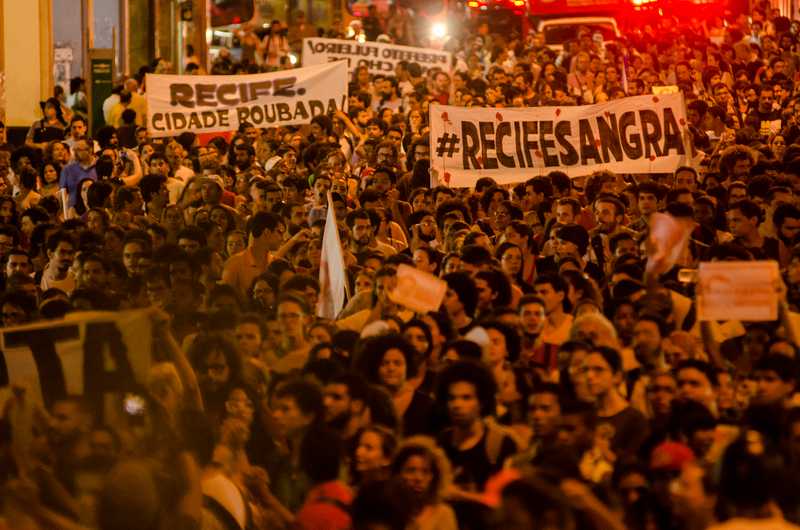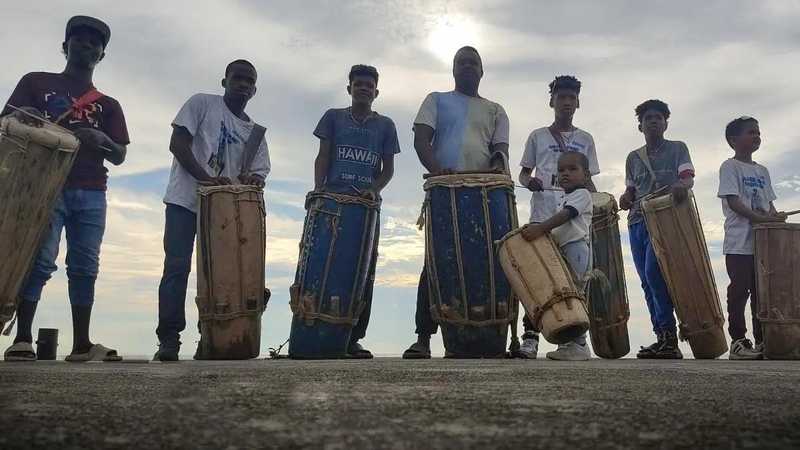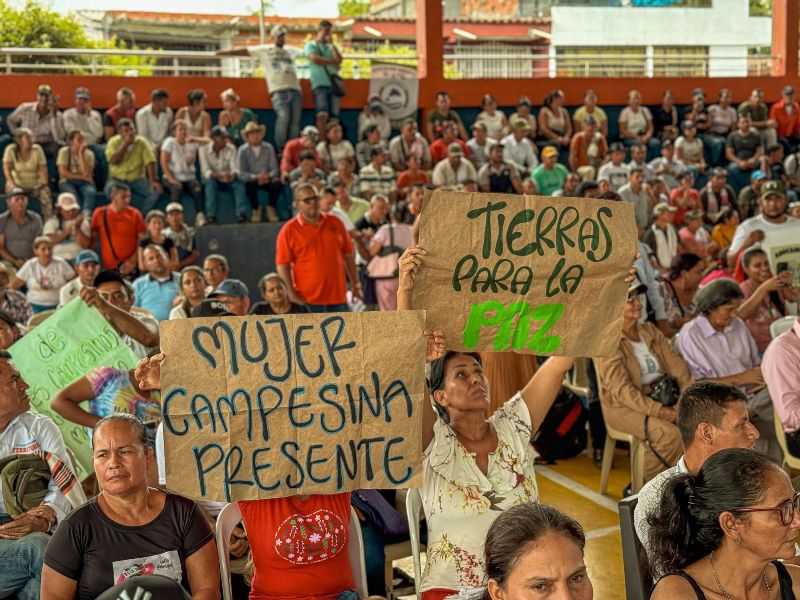The Ocupe Estelita, which took place in Recife (PE) is now 10 years old. It is a striking example of the strength and limits of social movements in the dispute over urban space. People from different social classes live together in cities, and where this difference is very evident, spaces without the minimum necessary for a dignified life coexist, such as the stilt houses in the Pina basin, and luxury projects, such as the one being built in a former public transport area, right in front of the recently removed stilt houses.
Characterized by a verticalization that was out of line with standards and limits, the project presented itself as a real barrier. Made up of 12 towers with more than 40 floors and a height of one hundred meters, interfering with the landscape, the memory of the city and the natural environment, due to the barrier to the sea winds, the historical environment, and the proximity to Recife's ground zero (Veras, 2014).
On the other side of the dispute are the real estate companies, with arguments that do not justify the lack of limits. Political agents who supported the project defended the "requalification" of the "abandoned area", and public transport technicians were enthusiastic about the possibility of installing a Light Rail Vehicle (LRV) to meet the new demand.
The New Recife Project versus the Ocupe Estelita Movement
The Novo Recife Project site, where the shunting yard for the lines linking the Port of Recife to the interior of the state used to operate, is located on the border between the Pina/Boa Viagem real estate expansion area and the Recife neighborhood, on the banks of the Pina Basin. To confront the economic power of real estate capital, represented by the four construction companies of the Novo Recife Consortium, the activists fought battles on different fronts. One of them was the fight to register the Pátio Ferroviário das Cinco Pontas, where there were still old sugar warehouses, as a historical landmark. The application for the registration emphasized the unity of the Antônio Vaz Island complex, which began with Maurício de Nassau (interview with Tomás Lapa, 2017). Which had also been fundamental in the recognition of the Recife neighborhood as a national heritage site.
Another front of the struggle was licensing in the City Hall's Urban Development Council (CDU), which included municipal technicians, representatives from Iphan, the Union Heritage Superintendence (SPU), the National Department of Transport Infrastructure (DNIT) and the municipal and state legislature, as well as representatives from NGOs advising social movements and other representatives of civil society. On the judicial front, they had the collaboration of members of the state and federal Public Prosecution's Offices.
The land, which in principle had also been the subject of proposals for the "Recife/Olinda Cultural Complex" - a tourism-based development project drawn up in a partnership between the three levels of government - was auctioned off in 2008, and the New Recife Project was presented to the CDU in 2012. From the moment they became aware of what was considered "one of the biggest urban planning blunders" in the city, academics, activists, technicians, members of NGOs and young activists, all those who opposed the project began to mobilize, always from calls via social networks, mainly from the "Direitos Urbanos" Group. The peak happened during the 27-day occupation of the land between May and June 2014.
What became known as the Ocupe Estelita Movement managed to cancel several CDU meetings, with the help of the courts. However, the project ended up being approved in a closed-door session, in the last days of João da Costa's (PT) mandate, even without the impact studies, prior approvals or the urban plan required by the Master Plan, and with several lawsuits in progress.
Occupations in front of the site had been going on since 2012, and in April 2013 another "protest" took place. On the night of 21 May 2014, an attempt to demolish the warehouses, despite court rulings to the contrary, only failed because local residents warned the activists. The information spread out quickly and more than 200 people rushed to the site, managing to stop the demolition.
To prevent the demolition from starting again, the idea of occupying the Dock was born; the activists brought tents and supplies and decided to spend the first night. The following day, the demolition was embargoed by Iphan, and some of the movement's lawyers obtained, in negotiations with the police, a commitment to suspend the repossession until the process was concluded.
The occupation gained strong support from Recife's artistic community: Kléber Mendonça, Nação Zumbi, Otto and Karina Buhr, Ney Matogrosso, and Zélia Duncan, were some of the names that supported the Ocupa Estelita Movement (MOE), as well as performances by the "Empatando Tua Vista" and "Eu acho é pouco" blocks, and "Som na Rural", a traveling music project that provided structure for the free events and concerts that brought approximately 10,000 people to the occupied Estelita. David Harvey, an influential geographer from the United States, visited the occupation and praised the unity of struggle and celebration.
Negotiation attempt
The demands of the members of the movement were: at least 30% affordable housing on the site, urban planning that treated the area with the complexity it required, and that it be discussed in the recently regulated City Council, which was considered more democratic than the CDU.
The new mayor, Geraldo Júlio (PSB), tried to mediate a negotiation with the creation of a forum made up of organizations representing lawyers, engineers, architects and the university, as well as businesspeople and activists. However, two conflicting points remained in the final document: the suspension of the project's approval on the consortium's side and the eviction of the land on the movement's side. Although the document established deadlines and guidelines for the "redesign" of the project, in reality, the city council was already counting on the use of violence for the eviction - which would take place the following day, on a holiday during the Brazilian national team's 2014 World Cup match.
Under the orders of the then governor of Pernambuco, João Lyra (PSB), the Military Police's (PM) riot and cavalry units used a lot of violence to remove the activists. Besides evicting the occupiers, the police destroyed documents and equipment. Computers, tents, and personal belongings were lost. It resulted in four people being arrested and dozens injured, "including children, elderly people and even a pregnant woman", with repercussions in the national and international press. After the eviction, some protesters remained for a few days under the nearby overpass, carrying out educational and mobilization activities (Varejão, Rafael and Araripe, 2016).
Violence during eviction
Meanwhile, in the architectural office of one of the companies, the "redesign" began, but without the participation of the protesters. The resulting proposal was presented at a press conference on 10 September 2014, without public access. It consisted of changes to the road system, the opening of cross streets and the connection with Dantas Barreto Avenue; the plot size was increased from five to eight blocks, the buildings near the Forte das Cinco Pontas would be lower, with another tower at the opposite end. The use changed from residential to mixed-use, with 65 per cent being green areas. There were small gains compared to the original project.
The activists denounced the lack of a specific urban plan for large plots of land, a requirement of Recife's Master Plan. The mayor decided to draw up a proposal that included the Santa Rita Dock, José Estelita Dock and Cabanga, but which "started the other way around: with a real estate project, which had already been approved" from which the City Hall "constructed a Bill that was in charge of transposing the real estate project into the dimension of the urban plan" (Varejão, Rafael and Araripe, 2016). Its approval took place in May 2015, in an extra-agenda vote by the municipal legislature, to which the movement reacted by occupying the outside area of the City Council, with protests that lasted several days, including an encampment in front of the mayor's house.
Operation Final Bid
When all seemed lost, a Public Civil Action, initiated in 2011, triggered the Federal Police's Operation Final Bid in 2015, with search and seizure warrants for documents at the companies' headquarters, the Superintendence of Union Assets (SPU) and DNIT, investigating possible irregularities in the land auction.
The land was sold on October 3, 2008, through an auction held by Milan Leilões, a company linked to Caixa Econômica Federal, in São Paulo and not in Recife, on the grounds that this would facilitate the participation of other companies from anywhere in Brazil. But only the Novo Recife Consortium showed up and bought the land, almost eleven hectares in size, for 55 million Reais, or 545 (five hundred and forty-five) Reais per square meter, when the average price at the time was more than six thousand Reais. (Varejão, Rafael and Araripe, 2016:292)
The Federal Police said in a statement that they had obtained evidence of fraud against the competitive nature of the auction, which constitutes a crime under the bidding law (Article 90 of Law 8.666/93), and asked the Federal Court to seize the property that had been auctioned. On 28 November 2015, Judge Roberto Wanderley Nogueira annulled the auction and ordered that the area be returned to the Union's Public Patrimony, as well as ordering the City Hall to refrain from authorizing "any and all projects that conflict with the historical, landscape, architectural and cultural environment of the areas surrounding the Cinco Pontas fort, including the José Estelita Dock, under the penalties of the law."
The recognition of the historical value of the old maneuvering yard was considered the main resource in the fight against development. Although Iphan published the approval of the historical, artistic and cultural value of the operational area of the Pátio Ferroviário das Cinco Pontas on March 17, 2015, and the inclusion of the stretch on the list of Railway Cultural Heritage, this recognition did not guarantee the recognition of the area. The appeals filed by the defendants, the City Council and the consortium, were accepted by the Regional Court, which reviewed the judge's decision, based on Iphan's conclusion that the Railway Yard should not be recognized as a landmark.
The demolition of the warehouses began in March 2017, despite renewed attempts by the protesters, who denounced the suspicious haste with which City Hall granted the demolition license immediately after Iphan's decision. Work on the first three towers began in 2019 and is now being completed, with the apartments in the first three towers available for sale.
Urban social movements are fighting for the investments that are essential for life in the city, whose administrators gradually adapted to "management" or "urban entrepreneurialism", when the world economy began the shift to the right known as neoliberalism and the city began to be treated as an instrument for profit. Conflicts are pacified by cappuccino (Saskia Sassen), entertainment and parties, the cultural industry and heritage tourism (Choay, 2001).
The characteristics of this time in the world are explained by Polanyi (2012) through the great transformation that took place in the economy from the beginning of capitalism, when markets came to prevail absolutely, instead of being rooted in the social relations of previous eras, when "equivalences between different goods were established by tradition or authority" and "stability, not fluctuation, was the norm". Everything has been replaced by the universalization of the market, which introduces a difference of degree that results in an unprecedented social organization, but not a "natural" one, but one based on heavy intervention by private and state powers, a "satanic mill", which, as Marx (2017) predicted, must always be in operation.
New forms of exploitation and accumulation are emerging every day, such as the current "accumulation by spoliation" of neoliberalism (Harvey, 1992), a "shameless" and fictitious capital, without limits, which circulates around the world without restrictions and which does not generate improvements that are enjoyed by majorities - only sumptuous, unproductive spending or war.
The verticalities of capital find resistance, however, in the horizontality of concrete life, in the daily struggle. The resulting spatial and social conformation will be defined by the capacity of the networks and stakeholders of the place (Santos, 2005). A struggle that also has other benefits, such as awareness, camaraderie, solidarity, joy and celebration, which captivate and excite their participants, who begin to see more meaning in life and have more hope for the future.
Marta Santa Cruz Pordeus is an architect and urban planner. Master in Urban Development and member of the BrCidades Network.
Foto: Outras Palavras
Bibliographical references
Arantes, Paulo (2014) O novo tempo do mundo. São Paulo: Boitempo.
Choay, Françoise (2001) A alegoria do patrimônio [The allegory of heritage]. São Paulo, UNESP.
Harvey, David (2014) Cidades Rebeldes: do direito à cidade à revolução urbana [Rebel Cities: from the right to the city to the urban revolution]. São Paulo: Martins Fontes.
____________ (1992) Condição pós-moderna [Postmodern condition]. São Paulo: Editora Loyola.
Marx. Karl (2017) O Capital Crítica da Economia Política Livro 1 [Capital: A Critique of Political Economy. Volume I: The Process of Production of Capital]. São Paulo: Boitempo.
Santos, Milton (2005) O retorno do território [The return of the territory]. Observatório Social de América Latina no. 16 [Latin American Social Observatory no 16]. 16. Buenos Aires: CLACSO.
____________ (2009) A Natureza do Espaço: Técnica e Tempo [The Nature of Space: Technique and Time]. Razão e Emoção [Reason and Emotion]. São Paulo: Editora da Universidade de São Paulo.
Varejão, L; Rafael, R; and Araripe, V. “A disputa entre o Novo Recife e o Recife que queremos: a trajetória do conflito pelo Cais José Estelita” in Oliveira, Fabrício Leal de (org) (2016) Planejamento e conflitos urbanos: experiências de luta. ["The dispute between Novo Recife and the Recife we want: the trajectory of the conflict over Cais José Estelita" in Oliveira, Fabrício Leal de (org) (2016) Planning and urban conflicts: experiences of struggle.]. Rio de Janeiro: Letra Capital Editora.
Veras, Lúcia (2014) Paisagem Postal: A imagem e a palavra na compreensão de um Recife urbano. [Postal Landscape: The image and the word in the understanding of an urban Recife.]. PhD thesis in Urban Development. Recife: MDU/UFPE.



